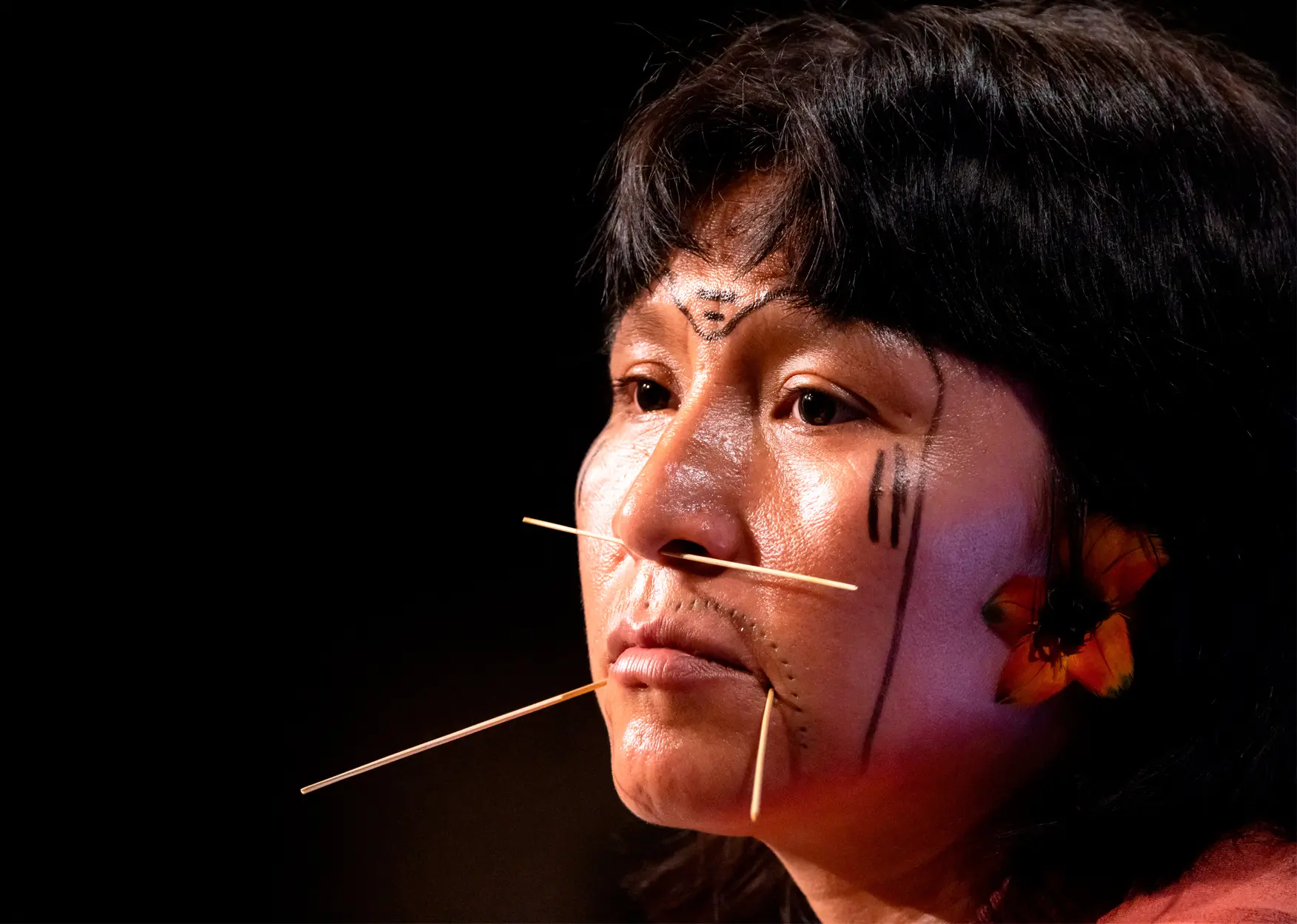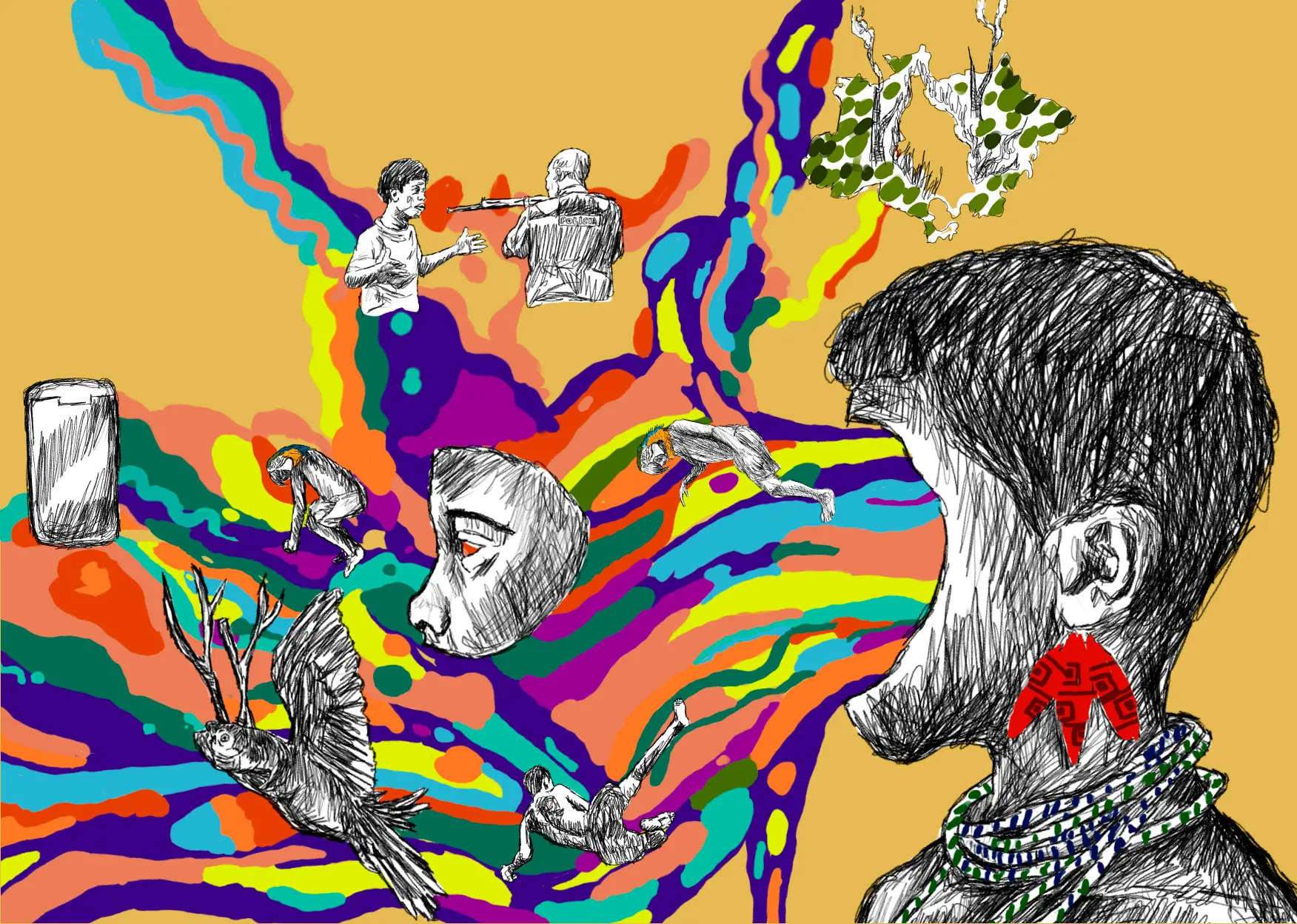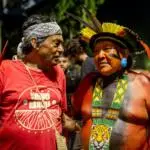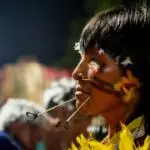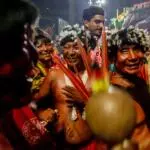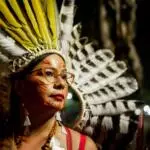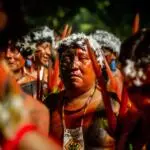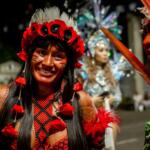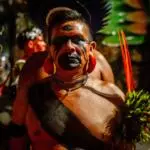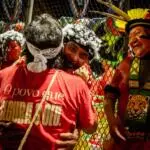It was Davi Kopenawa’s seventh day in Rio de Janeiro. The Salgueiro samba school had gathered at the entrance to the parade route, waiting its turn to join the procession of Rio’s winning Carnival schools, held on February 17. The Yanomami leader and shaman was being bombarded with requests for yet another photo, yet another interview. While Davi complained about having to “repeat over and over,” he eventually gave in with a smile, reaching out to embrace members of Salgueiro, who approached him for selfies more timidly than the anthropologists, Indigenous specialists and camera operators who were also there.
For the Yanomami, everyone’s vital image—pei utupë—is a component of the person. A person’s vital image detaches from their body during a dream; it is their reflection and shadow; and it is also reproduced in a photograph or video on television. The way social events have been taken over by cell phone pictures, Davi Kopenawa seems to have become an object everyone wants to photograph, post, and share. Someone told him his utupë was tired of being captured all the time. The Yanomami shaman, whose age is estimated at 70, quit looking serious and broke into an astute smile, gesturing as if pulling something invisible from the cell phones. “No,” he announced in a humorous tone, “I’m taking my utupë back!”
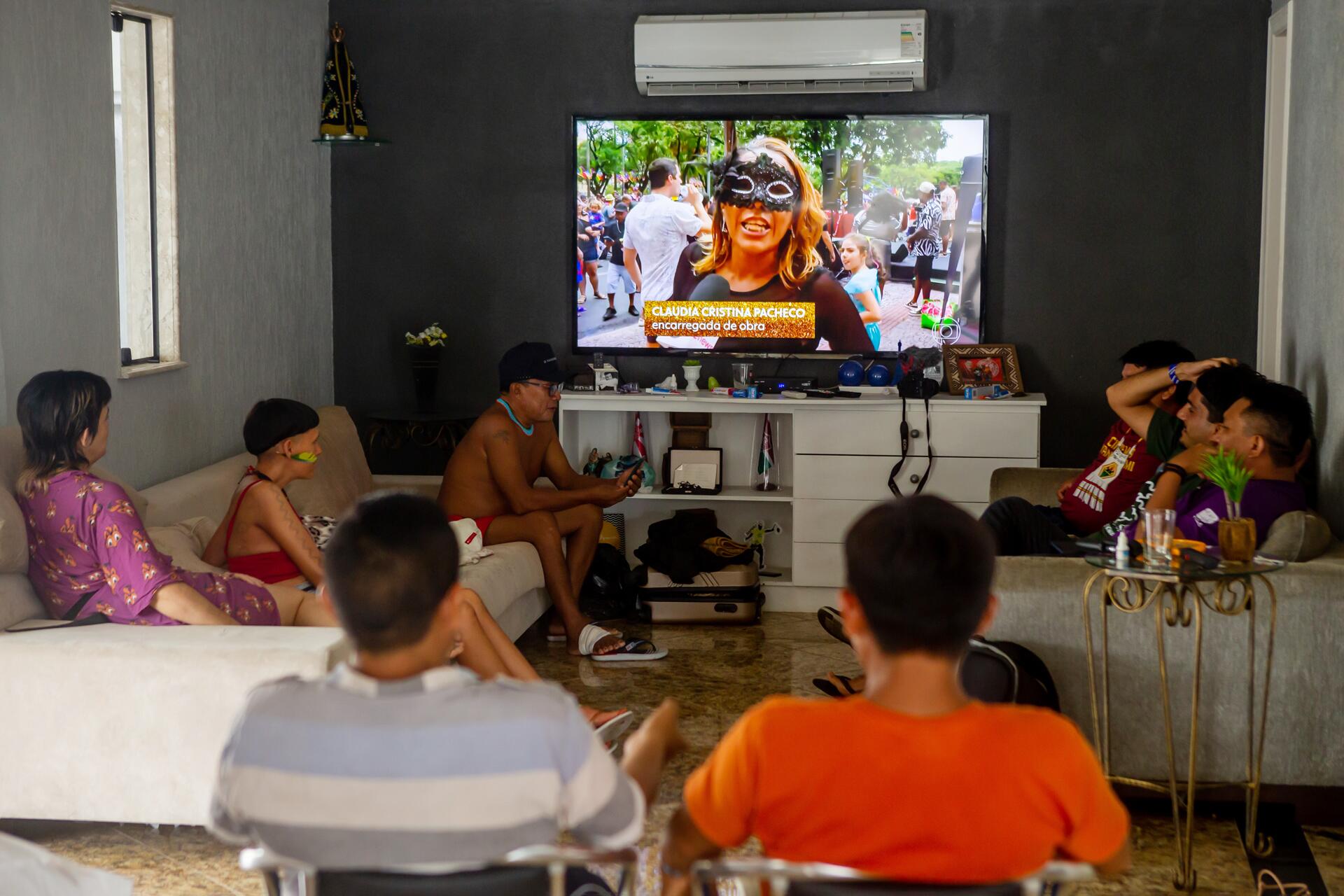
Glued to images of Carnival playing nonstop on TV, some of the Yanomami visitors from the Amazon relaxed in the house where they stayed
Davi Kopenawa often makes caustic comments about the large metropolises where the “commodities people” live. The effusive Carnival energy around him contrasted sharply with the silence and calm of the Yanomami forest-earth. Davi cursed the polluted Mangue Canal because a rotten stench was rising from its waters, right where the Yanomami were waiting for the parade to finally start. Built in the 19th century to receive water from streams that had emptied into a mangrove swamp before it was covered by landfill, the canal runs the length of Avenida Presidente Vargas, where schools gather downtown before the parade.
The city is “ruined forest,” Davi Kopenawa said. “You have to pay for everything here, and what Omama [creator of the Yanomami] left us is free,” he added. He had journeyed to Rio de Janeiro to defend this heritage—“the right to our forest, the right to care for our clean water”—and so he prepared to climb back on the float entitled “Brazil in a headdress,” the sixth and last car in Salgueiro’s parade. The school’s central theme was “Hutukara,” the Yanomami name for the first sky, which fell to form today’s earth. Ever since, the Yanomami believe they have worked to hold up the new sky.
Political figures, shamans, and artists from the forest
The book The Falling Sky, co-authored by Davi Kopenawa and the anthropologist Bruce Albert, was the key source of inspiration for the Salgueiro samba school’s theme, which showcased the worldview of the Yanomami people and their resistance to genocide. However, in the opinion of Rio Carnival specialists such as Mauro Cordeiro and Luiz Antonio Simas, the school’s scenography didn’t live up to the power of its theme or its samba, sharp as an arrow and soon on everyone’s lips. The school opened its parade with a stunning performance by a group of grand marshals, with Brazilian actress and dancer Cleia Santos in the lead, followed by a series of giant, dazzling floats featuring Yanomami people and animals. But the show ended without the school demonstrating the requisite technical excellence or offering that cathartic moment when everybody concludes: “There’s the winner!”
One of Salgueiro’s mistakes was to assign to a single float all 13 Indigenous people who had come from their territory, straddling the states of Roraima and Amazonas in the Amazon rainforest. Many of them had traveled two days by river and road to reach Manaus or Boa Vista, where they then caught a flight to Rio. From the stands, it was hard to make out the Yanomami participants in the middle of all the feathered adornments and all the non-Indigenous “destaques,” star performers dressed extravagantly. Among them was a man wearing a striking hornet costume, an allusion to the origin of the name Kopenawa in the Yanomam language. The man was dancing at the top of the car, high above Davi and the two shamans accompanying him, so the performer stood out more than the most eminent leader of the Yanomami people, whom the crowds were eager to see.
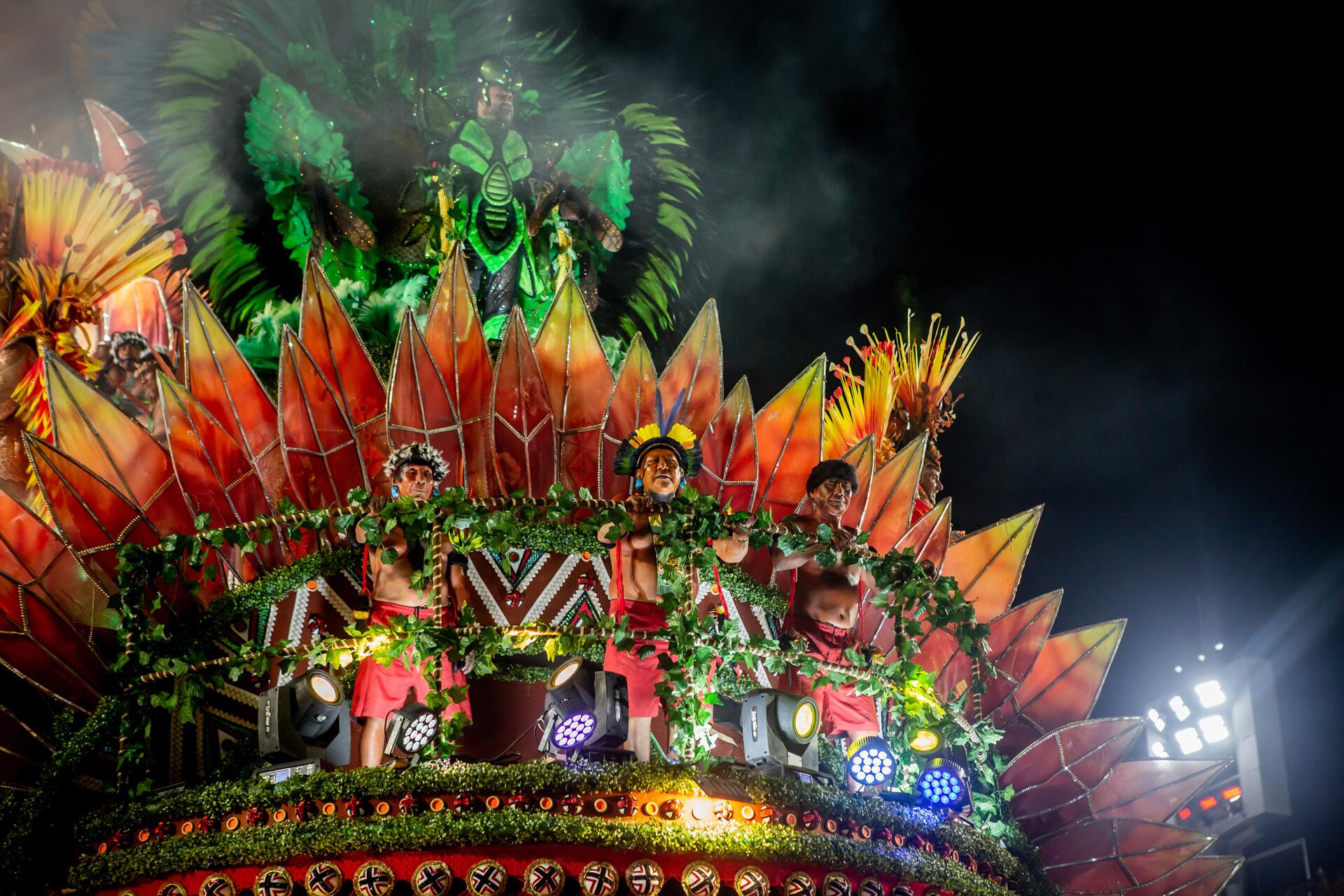
Shamans Manoel (left), Kopenawa (center), and Pedrinho on the float. Above them, a star performer dressed as a hornet, or kopena in the Yanomam language
The Yanomami who were at the Sambadrome arena on Avenida Marquês de Sapucaí were people of renown from politics, arts, and shamanism. Davi, president of the Hutukara Yanomami Association, had also invited leaders from the other main associations with whom the Yanomami have good diplomatic relations in the same Indigenous territory. Heads of three associations from the Upper and Middle Rio Negro regions in Amazonas—Otávio Ironasiteri, João Figueiredo, and Julião Komixipiweitheri—were there as well, along with Júlio David Rodrigues, who represented the Ye’kwana, the other ethnic group living in the territory, and Carla Lins, an educator and president of the Yanomami Kumirayoma Women’s Association. Also in the group were Dário Kopenawa, Davi’s son and vice president of the Hutukara association, and Geraldo Kuisithēri, who represented his people at the United Nations Conference on Environment and Development, or Earth Summit, held in Rio de Janeiro in 1992, the year the Yanomami Indigenous Territory was ratified.
Davi Kopenawa also chose two shamans, Manoel and Pedrinho, to attend the biggest people’s party in Brazil. Manoel is a respected shaman of the Hemarapiwei community, in the Demini River region, who knows little about the world of napëpë, or white people, but his deep voice echoes through the shamanic world, where he is known to journey across landscapes unknown to the non-Indigenous. As the Salgueiro samba school assembled to enter the parade route, Manoel’s eyes followed the swaying movements of the samba dancers, dressed in colorful outfits inspired by shamanism. Pedrinho, the son of Davi’s father-in-law, who was a great shaman, said the costumes reminded him of the images of the xapiri evoked during shamanic sessions, when the spirits descend in their adornments to help the shamans care for the ill and the forest-earth.
At a time when Yanomami art and cinema are thriving, Salgueiro drew on the work of visual artists Joseca Mokahesi and Ehuana Yaira in designing the school’s floats and costumes. Joseca was pleased to see his delicately designed flowers gain new dimensions when reproduced on the skirts of baianas, the parade wing made up of older women who whirl down the avenue in huge hoop skirts. His translations of the world of the xapiri are rooted in the shamanic songs and descriptions he has heard since birth. If his work danced at Rio’s Carnival, in April it will travel even farther, to be exhibited at the Venice Biennale, the leading contemporary art show. High up on the float, the filmmaker Morzaniel Ɨramari watched more than he danced. In 2023 Morzaniel won best short film at Brazil’s international festival “It’s All True,” with Mãri-Hi: The Tree of Dreams, which had been a candidate to represent Brazil at the 2024 Oscars.
In January, Salgueiro asked Ehuana Yaira to paint an image of the Indigenous specialist Bruno Pereira and journalist Dom Phillips, murdered in 2022 in the Javari Valley, in the Amazon. This was the first major painting done by the Yanomami artist, who moved from drawing with colored markers to experimenting with acrylic. Carried down the parade route by the Indigenous specialists who formed the wing called “Friends of the Yanomami,” the huge painting closed the show. Joy exorcized anger. Riding atop this final float, along with representatives of other Indigenous peoples, such as Ailton Krenak and Daiara Tukano, was Dom Phillips’s wife, Alessandra Sampaio, who was visibly moved.
During the parade of champions, Ehuana and the nurse Clara Opoxina, who has been working with the Yanomami for 12 years, traded the float for the ground. As spectators in the stands applauded, Ehuana danced with open arms, displaying the same energy and enthusiasm that drives her during dances at reahu, the festival where the Yanomami process the ashes of their dead, in the company of visitors from other villages.
It was past three in the morning on February 18 and, at the exit of the parade of champions, a group of Salgueiro members from the xapiri wing were lamenting the fact that the saga of the Yanomami hadn’t earned their school the title of champion. One of them suggested Davi Kopenawa should have appeared on the first float, which featured the school’s emblem. Another said the school should have depicted the falling sky, that is, the prophecy of the Yanomami shamans, who are responsible for holding up the sky, which will fall if the napëpë continue their greedy destruction of nature.
By then, however, it was all water under the bridge. While Salgueiro lost points on floats and costumes, their performance in the categories that depend on the enthusiasm and discipline of parade participants—central theme, overall harmony, and flow and spirit—garnered them fourth place and the chance to return to the Sambadrome arena next year as one of the top six out of twelve schools. Unidos de Viradouro took first place this year, with a theme centered on the cult of a fertility vodum, or spirit, represented by a snake and brought to Brazil by enslaved Africans from former Dahomey, now Benin.

Watching the judging on a big screen, Salgueiro samba school members and Yanomami guests (seated in first row) cheer when the school earns yet another perfect ten
Echoes of ‘Ya temi xoa’
The discussion that consumed avid samba school fans in Rio, about which parade was the best, was of no interest to the Yanomami entourage. Two days after the parade, they were relaxing in the house where they were staying in Vargem Pequena, on the far west side of Rio, some 25 miles from downtown. In the living room, the television showed nothing but scenes of samba schools and the street performances known as blocos. From time to time, someone in the house would sing out “Ya temi xoa,” the refrain of Salgueiro’s samba, which means “I’m still alive.”
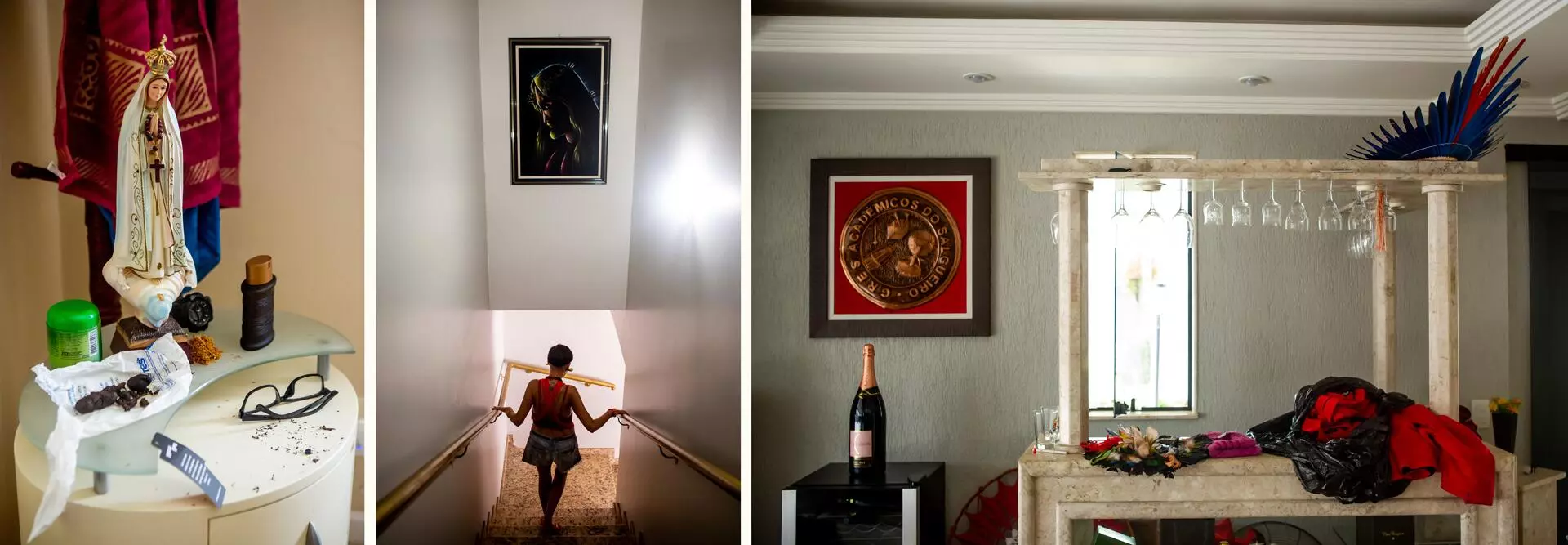
Tobacco and other items brought by the Yanomami, next to a statue of Our Lady (left) and on the bar in their lodgings (right); in the center, Clara Opoxina going downstairs
The house where the Yanomami were lodged belongs to André Vaz, president of Salgueiro. It was a two-story home, decorated with an altar to São Jorge—the Catholic saint associated in Afro-Brazilian religions with Ogum, the warrior orisha—along with images of Our Lady and certificates of past Salgueiro victories. A huge whirlpool bath occupied the largest bedroom, used by some of the Yanomami. Igor Ricardo, who wrote the thematic synopsis submitted to the parade judges, had already met Davi Kopenawa and served as the school’s contact with the Yanomami in Rio. Igor made sure everyone had a bed but rather than sharing rooms, the men asked for hammocks and ropes so they could sleep on the porch. After the parade, the annatto the Yanomami use to paint their bodies left red marks in the house, decorated in shades of white. “Salgueiro had better win, so the owner of the place won’t get mad at us,” one of them said.

Joseca and Pedrinho in a bedroom of the house owned by Salgueiro president André Vaz. Manoel inspects the whirlpool bath
While the rest of the group chatted in the living room and bedrooms, Davi Kopenawa was out on the porch alone. From there, looking out over the high wall, it is possible to spy a piece of Pedra Branca State Park, an urban conservation unit. Davi said he had visited the whole area in his dreams, and he held up a jar of yãkoana, a hallucinogenic powder, made from the sap of trees of the genus Virola, that feeds the xapiri and allows shamans to venture farther in their dreams.
In the parade, yãkoana was represented by the bright red costumes of the flag bearer, Marcella Alves, and her dancing partner, Sidclei Santos, awarded a perfect ten by the jury. After the first parade, Marcella gave an interview to the television network Globo, in which she explained the importance of this substance and its relation to shamanism. At the parade grounds, yãkoana played another role: it let the shaman Pedrinho see the xapiri napënapëri—the spirits of the white people there. It was at these intersections that the Amazon met Rio’s Carnival.
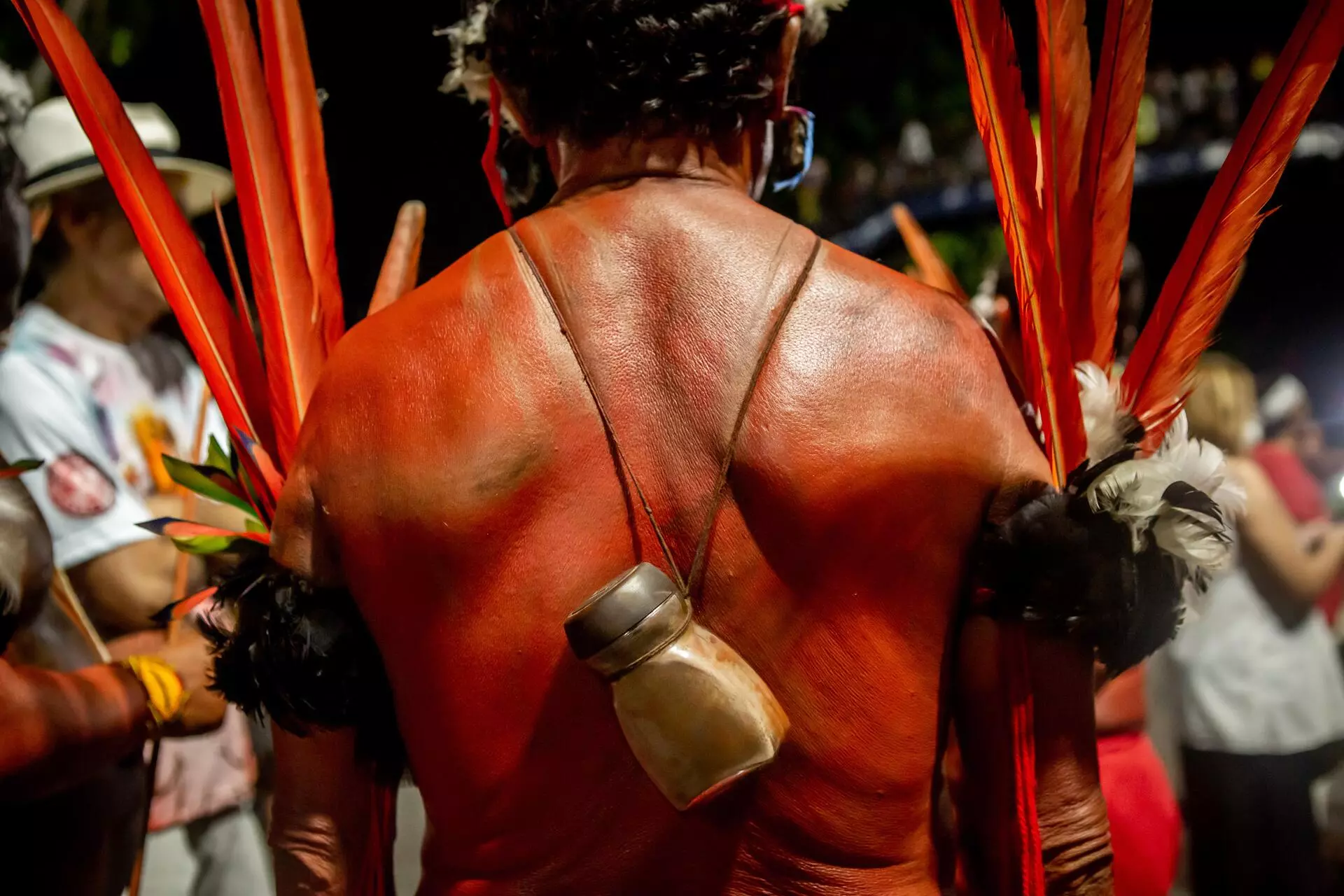
Manoel carries a jar of yãkoana, the hallucinogenic powder used by shamans to feed the xapiri – the spirits of every human and more-than-human being in the forest
Seeds of an alliance
Davi Kopenawa spoke several times about the “alliance” established between the Yanomami and Black people. He said it had taken time for them to meet, but they were finally joining forces to fight for respect and their rights. It is hard to predict whether—and how—this alliance might unfold. André Vaz, Salgueiro president, said the Yanomami people will have his “eternal gratitude” and the school “will always defend this cause.” But samba schools shift their focus to next year’s parade as soon as Carnival is over.
Yet a seed had been planted.
On February 14, Ash Wednesday, the Yanomami watched the judging at Salgueiro’s rehearsal grounds, in the neighborhood of Andaraí. The school held a ceremonial planting of young trees in the only corner of soil there, a meager garden covering about 200 square feet. People crowded around to witness the moment. The saplings were slow to arrive, and the older women from the wing of twirling baianas grew impatient because the League of Samba Schools was about to announce the scores assigned by the jury. But Davi followed the script and carried out the rite, surrounded by children from Salgueiro.
First he took the mahogany saplings from their pots. Alongside him, Ehuana sang a chant for the planting. Standing by the holes dug to receive the young plants, Davi stomped his feet three times. The shaman Manoel explained that the Koyori—the leaf-cutting sauba ant, one of the Yanomami’s animal ancestors—stamp their feet like this. Koyori was the creator of gardens and tramping the ground was a way of bidding each plant to flourish. This was Davi’s way of ensuring fertility so the trees would grow in memory of a great meeting at Carnival.

Kopenawa and Ehuana perform a Yanomami rite while planting mahogany saplings at Salgueiro’s rehearsal grounds, evoking the sauba ant Koyori, creator of gardens
During the judging, the Yanomami sat in the first row. Right behind Davi Kopenawa was Ana Carolina Oliveira da Silva, an elementary school teacher who this year paraded in the wing representing the banana harvest, composed of Yanomami women. Ana Carolina called Clara over to give her a hug and thank her for posting a video on social media, where the nurse sings the school’s theme song, sitting in a boat on a river in the Amazon. Ana Carolina said she was moved by what she described as an “Afro-Indigenous fusion.” She explained: “This samba theme wasn’t just needed; it signaled the needed fusion of those of us who built all this. This is history. I’m committed to taking opportunities to revere these peoples on a daily basis, not just on November 20 [Black Awareness Day] and April 19 [Indigenous Day].”
This coming together of the forest-earth and the neighborhood of Morro do Salgueiro produced a powerful theme, one that broke out of the Carnival bubble while lending visibility to the Yanomami in their fight to exist. In the spaces between the pragmatic interests of one side and the other, intense encounters bloomed. Everyone drew strength from a refrain chanted in an Indigenous language in a land where the original peoples have been exterminated and millions of Africans arrived enslaved: “Ya temi xoa!” To stay alive, they will need to unite in the spaces opened up by their meeting, joining in common struggles so the shamans can continue holding up the sky.
Report and text: Cláudia Antunes and Ana Maria Machado
Fact-checker: Plínio Lopes
Proofreader (Portuguese): Valquíria Della Pozza
Spanish translation: Meritxell Almarza
English translation: Diane Whitty
Photo editor: Lela Beltrão
Layout and finishing: Érica Saboya
Editors: Viviane Zandonadi (editorial workflow and copy editing), and Talita Bedinelli (editor-in-chief)
Director: Eliane Brum

